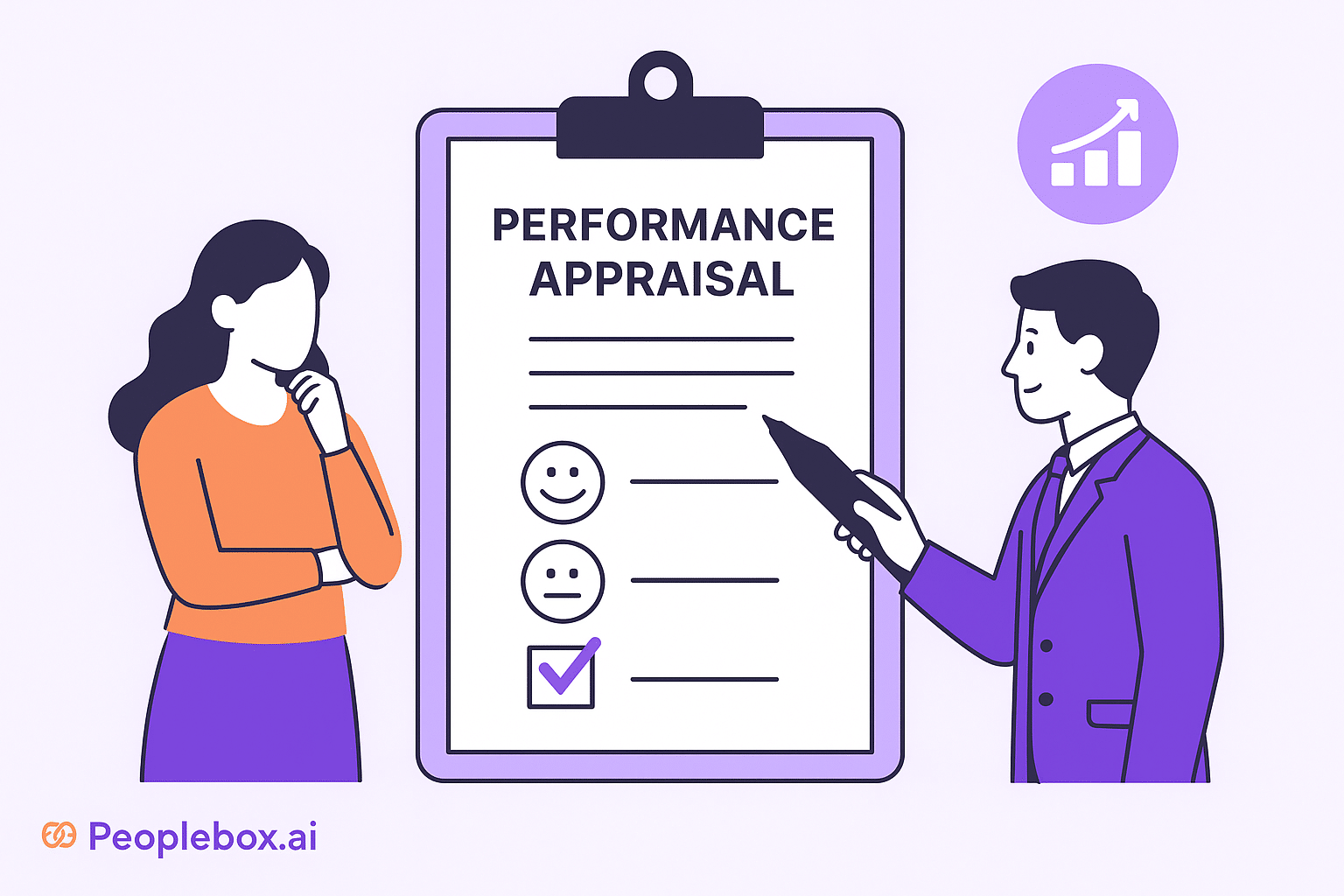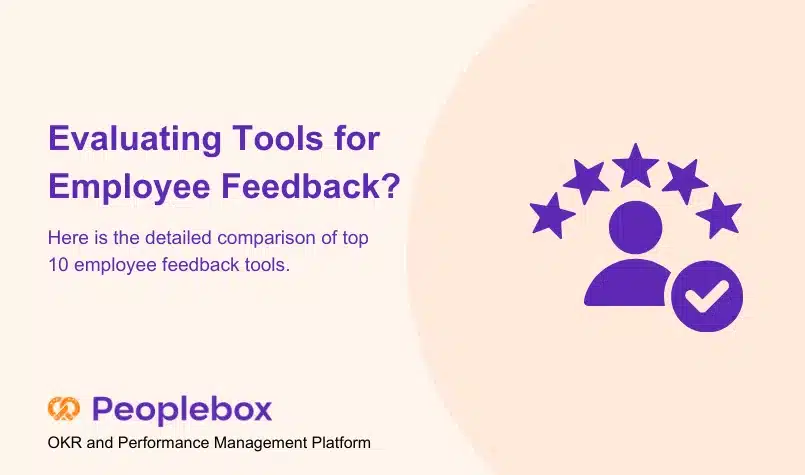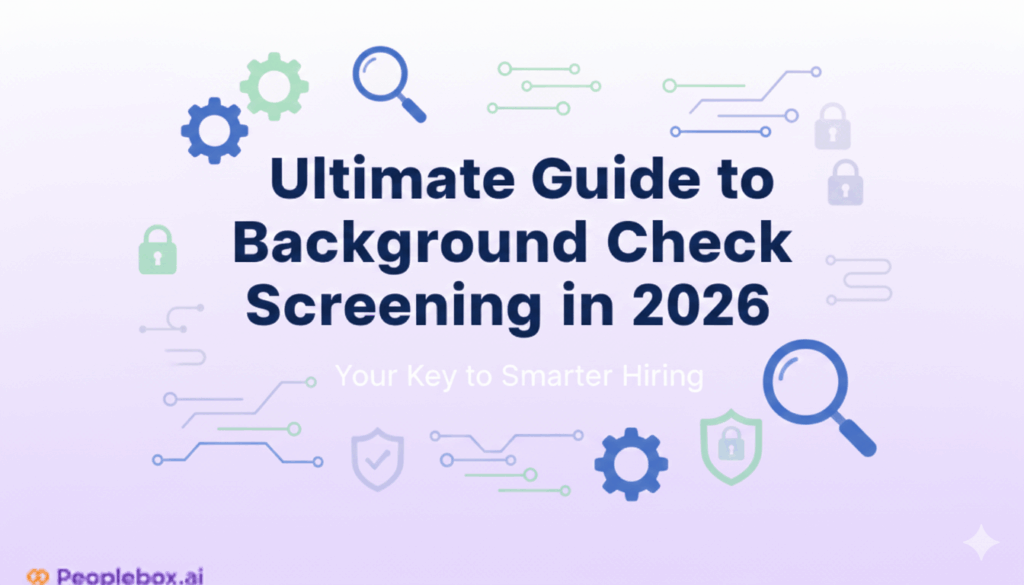TL;DR
Traditional performance appraisals like rating scales, checklists, essays, and confidential reports provide structured ways to assess employees, but they can be slow, biased, and infrequent.
Modern approaches with real-time feedback, automation, and actionable insights make performance management simpler, fairer, and more impactful.
Performance reviews are stuck in the past. Are they really helping employees grow or just filling out forms?
Traditional reviews are slow, inconsistent, and often demoralizing. Employees wait months for feedback that may never help them improve. So, how can you make things more modern to keep up and help your employees get better?
| Even if you’re familiar with the concept, here’s a quick refresher on performance appraisals: Performance appraisal is the process of evaluating an employee’s work, skills, and overall contributions over a set period. It helps highlight strengths, identify areas for improvement, and ensures that individual performance aligns with team and company goals. Essentially, it’s a structured way to give feedback, recognize achievements, and support employee growth. |
Understanding Traditional Performance Appraisal Methods
Traditional appraisals track performance and provide structured feedback, but they’re often too infrequent to drive real improvement. Only 43% of highly engaged employees receive weekly feedback, highlighting a gap in traditional systems.
But, these older ways of doing things can have problems. They might not show how someone is doing all the time, and they can be unfair, not happen often enough, or make people feel bad. They also might not give you info right away, which can make it hard to do well in fast-paced jobs.
Common Traditional Methods of Performance Appraisal
Here’s a quick refresher on the traditional methods commonly used to evaluate performance.
1. Rating Scale Method
This method uses a list of things to look for to judge employees in a regular way. These things are usually specific to the job, like how good their work is, if they’re on time, how well they work with others, how they communicate, and if they reach their goals. Each thing gets a number, usually from 1 to 5 or 1 to 10.
How It Works: Managers use forms with different areas of performance to judge. They give employees a rating for each area using the scale, and they often give examples of what each rating means.
Advantages:
- Standardization: Makes sure everyone in similar roles is evaluated using the same fair criteria.
- Simplicity: Easy for everyone to understand and apply, no matter their level in the organization.
- Quantifiable Results: Gives clear numbers you can compare and analyze to see how things are going.
- Time Efficiency: Relatively quick to complete compared to more complex evaluation methods
- Legal Defensibility: Creates documented evidence of performance evaluations
Limitations:
- Central Tendency Bias: Evaluators may tend to rate everyone as “average” to avoid difficult conversations
- Halo Effect: One strong or weak performance area may influence ratings in other areas
- Numbers don’t tell the whole story: They can’t capture the “why” behind someone’s success or struggles.
- Ratings can mean different things to different people: What’s a “4” for one manager might be a “3” for another.
2. Checklist Method
The checklist method has managers use a list of sentences or actions related to how someone does their job. They check off the things that are true about the employee, which makes a picture of their performance.
How It Works: Managers go through a list of positive and negative statements about how an employee works and behaves. They simply tick the ones that best describe the person. For example: “Always meets deadlines,” “Great at solving problems,” or “Needs closer supervision.”
Advantages:
- Covers everything that matters: Makes sure all key areas of performance are reviewed.
- Focuses on real actions: Looks at what can be seen and measured, not just opinions.
- Keeps things fair: Helps avoid big differences in how different managers rate people.
- Creates a clear record: Leaves a detailed, written track of specific strengths and areas to improve.
Limitations:
- Binary Thinking: Items are typically yes/no, missing nuances in performance levels
- List Limitations: May not capture unique aspects of individual performance
- Time Intensive: Can be lengthy to complete thoroughly
- Update Requirements: Lists need regular updates to remain relevant
3. Paired Comparison Method
In this method, managers compare each employee to every other employee, one pair at a time. The person who does better in each pair gets picked, and then you count how many times each employee was picked as better to rank them.
How It Works: For each pair, the manager decides who does better overall or in certain areas. After comparing everyone, employees get ranked by how often they were picked as the better performer.
Advantages:
- Relative Performance Assessment: Provides clear relative rankings within teams
- Reduces Central Tendency: Forces differentiation between employees
- Eliminates Rating Scale Bias: Removes the ambiguity of interpreting numerical scales
- Clear Hierarchy: Creates unambiguous performance rankings
Limitations:
- Time Consuming: Becomes exponentially complex with larger teams (n(n-1)/2 comparisons)
- Limited Scope: Only shows relative performance, not absolute performance levels
- Forced Rankings: May create artificial distinctions between similarly performing employees
- Team Size Limitations: Becomes impractical with large groups
| Want to improve your performance reviews? Check out these helpful resources: Performance Appraisal Guide for 2025Top Performance Appraisal Software |
4. Confidential Report Method
The Confidential Report method is one of the oldest approaches to performance evaluation. In this method, a supervisor quietly assesses an employee’s work covering everything from the quality of their output to their teamwork, discipline, contribution to the organization, and overall effectiveness.
How it works:
Instead of scores or quick checklists, the supervisor writes a detailed narrative that captures the full picture of specific achievements, challenges the employee has faced, skills they’ve developed, and where they could grow next.
These reports are usually shared only with senior management and HR, keeping the process private.
Advantages:
- Privacy that encourages honesty: Because it’s confidential, supervisors can give open, unfiltered feedback without worrying about immediate conflict.
- A full-picture view: Goes beyond numbers to look at context, milestones, and growth over time.
- Thorough documentation: Becomes a reliable record for promotions, training needs, or succession planning.
- Authentic evaluations: The private format often leads to more candid and accurate assessments.
Limitations:
- One-sided perspective: Since it’s based only on the supervisor’s view, valuable input from peers or direct reports can be missed.
- Lack of transparency: Employees might feel left out of the process, which can lead to mistrust or disengagement.
- Time-consuming: Writing a detailed, thoughtful report takes significant effort.
- Limited immediate impact: Without sharing the feedback directly, employees may not get the chance to act on it right away.
5. Essay Appraisal Method
The essay appraisal method is like giving someone a thoughtful letter instead of just a scorecard. Instead of ticking boxes or assigning numbers, managers write a detailed narrative about an employee’s performance covering their strengths, potential, challenges, achievements, and overall contribution to the team.
How It Works:
In practice, the evaluator writes a comprehensive account of how the employee has performed over a set period. This might include real examples of great work they’ve done, specific moments where they handled challenges well, observations on their behavior and teamwork, and suggestions for where they could grow.
Advantages:
- Depth and Detail: It’s not just about “good” or “needs improvement.” The essay format captures context, emotions, and specific moments that a score can’t.
- Personalized Feedback: Every employee gets feedback tailored to their unique role, personality, and contributions.
- Context Matters: It’s easier to acknowledge external factors like unexpected project challenges or resource constraints that influenced performance.
- Growth-Oriented: Managers can give targeted advice for improvement and career development, making the feedback more actionable.
- Increases Ownership: Because the feedback feels personal and specific, employees are more likely to take it seriously and act on it.
Limitations:
- Dependent on the Writer: The quality of the appraisal depends on how skilled, objective, and observant the evaluator is.
- Hard to Standardize: Different managers may have very different writing styles and levels of detail, making comparisons tricky.
- Time-Intensive: Writing thoughtful, well-rounded essays for each employee takes a lot of time.
- Room for Misinterpretation: Without clear standards, employees might misread the tone or intent of certain comments.
- Difficult to Compare Across the Board: Since it’s all narrative, putting two employees side by side for evaluation purposes isn’t straightforward.
6. Forced Distribution Method
The forced distribution method makes managers put employees into certain groups, like high performers, okay performers, and low performers. This often follows a bell curve, making you put a certain number of employees into each group.
How It Works: Companies set how many people should be in each group (like 20% high performers, 70% okay performers, 10% low performers). Managers have to put their team members into these groups based on those numbers.
Advantages:
- Eliminates Central Tendency: Prevents managers from rating all employees as average performers
- Clear Differentiation: Forces identification of top and bottom performers within teams
- Compensation Alignment: Supports merit-based pay decisions by creating clear performance tiers
- Performance Accountability: Encourages managers to make difficult performance distinctions
- Organizational Benchmarking: Creates consistent performance standards across different departments
Limitations:
- Artificial Constraints: May force managers to place good performers in lower categories due to quota requirements
- Team Dynamics: Can create unhealthy competition and damage collaboration within teams
- Perceived Unfairness: Employees may view forced distributions as arbitrary or unfair
- Morale Impact: Lower-rated employees may become demotivated regardless of their actual performance quality
- Size Limitations: Works poorly with small teams where statistical distributions don’t apply naturally
Modernizing Traditional Appraisal Methods with Technology
Traditional performance appraisal methods are changing with the help of new tech. Platforms like PeopleBox.ai make these old methods better by putting processes online, doing calculations on their own, and giving info right away to make things more correct and fast. Here’s how tech is changing traditional appraisals:
- Bias Detection: Smart analytics spot hidden bias in reviews, helping keep assessments fair and fact-based.
- Multi-Source Integration: Combine traditional reviews with 360° feedback and real-time data for a fuller performance picture.
- Real-Time Analytics: Track trends as they happen, address issues early, and celebrate wins sooner.
- Automated Workflows: Automation handles admin so managers can focus on real conversations, not paperwork.
Conduct Effective Performance Appraisals with Peoplebox.ai
Let’s talk about performance reviews. It’s all about checking in on an employee’s work, skills, and contributions. We want to see what they’re doing well, where they could get better, and how their work lines up with what the team and the company are trying to achieve.
For years, companies have used things like rating scales, checklists, and written reports to assess employees – those ways of doing things give you structure, keep records of things, and a sense of things being done fairly.
But things change so fast at work now. Sticking only to those old methods can cause problems. They can feel slow and not give the employee a real voice. Plus, they might not show what the person actually does every day. That’s where Peoplebox.ai can be useful. This doesn’t get rid of the methods that are still useful, it just makes them easier to use and more valuable.
✅ Make the whole thing easy: Get rid of the need to hunt down forms or gather feedback from all kinds of places.
✅ Make feedback ongoing: You can still plan formal reviews during the year, but you will also have regular check-ins and automatic reminders.
✅ Make sure everyone is being treated fairly: Find any biases and get feedback from different places to get a broader view of the person’s overall performance.
✅ Make ideas turn into reality: With real-time data, you can see the wins, fix the problems quickly and monitor progress.
With Peoplebox.ai, you can keep the processes you trust like ratings, essays, and checklists while also:
- Easily gathering feedback from the employee, their co-workers, managers, and those who report to them.
- Automating check-ins, so you can keep track of progress all year round.
- Making sure that how the individual is performing connects to the business goals, using OKRs.
The result? A simpler, more open review process that keeps what works, gets rid of what doesn’t, and makes performance management less of a chore better to prepare everyone for the future.
Wrapping It Up: The Future of Performance Appraisals
Traditional performance appraisals provide structure and a way to evaluate employees, but they can be slow, biased, and sometimes unhelpful. The trick is knowing what works, what doesn’t, and blending the right methods with technology.
Peoplebox.ai modernizes traditional appraisal methods without losing their benefits, making feedback faster, fairer, and more actionable.
The most effective companies combine proven appraisal techniques with new ideas and tools, creating performance management systems that support both accurate evaluation and meaningful employee growth.
Ready to upgrade your reviews? Peoplebox.ai helps you merge what’s proven with what’s possible.
Frequently Added questions(FAQs)
How often should traditional performance appraisal methods be used?
Traditional performance reviews should usually happen at least once a year, but lots of companies do them twice a year. But, how often depends on what your company needs, what your industry does, and what you want to do for your employees. You can also have more regular check-ins to go with the formal appraisals.
Can traditional methods go with new performance management ways?
Yes, traditional methods can work well with new ways like constant feedback, 360-degree reviews, and watching performance all the time. This mix keeps the structure of traditional methods while adding the flexibility and ideas of new ways.
What problems might managers have when using traditional appraisal methods?
Common problems are being unfair in judging, taking too much time, having trouble keeping the judging the same between managers, and not being able to give feedback right away. You can fix these problems with good training, clear rules, tech help, and regular talks to make sure everyone’s on the same page.
Which traditional method is best for small companies?
For small companies, rating scale methods and essay appraisals often work well because they’re simple and flexible. Paired comparison methods might be hard with very small teams, and forced distribution methods might not be right because you don’t have enough people.
How can tech make traditional performance appraisal methods better?
Tech platforms like PeopleBox.ai make traditional methods better by doing work for you, finding bias, giving info right away, having set forms, and being able to work with other things. These changes keep the good parts of traditional ways while fixing their problems and making them faster and more helpful.






